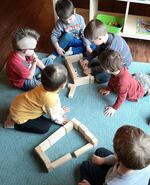On March 23, Gov. Kate Brown issued an order to child care centers in an effort to stem the spread of the coronavirus: abide by strict new emergency rules, or close.

A group of children play with blocks at Wonders Early Learning Center in Corvallis, The child care center closed in mid-March 2020, at the same time public schools closed due to the coronavirus pandemic.
Courtesy of Jennie Dalgas / Wonders Early Learning Center
But some child care centers had already closed before that. And some tried to stay open, following the new emergency rules — and wound up closing anyway. The difficulties that child care centers are experiencing could pose a problem, as counties across Oregon reopen and look to workers to return ... only to find that working parents can't find care for their children.
Take the experiences of two child care centers in Corvallis:
'Welcome to my bad dream'
Wonders Early Learning Center had already shut down by the time Brown gave her “follow these rules or shut down” ultimatum. Like many daycares and preschools, Wonders generally took its cues from local schools. Brown's order to close schools came 11 days before her broader shut down rules.
Wonders Early Learning Center director Jennie Dalgas recalled that the announcement came on Thursday, March 12.
"So that Friday, I woke up to a bunch of panicked teachers saying, 'What are we going to do?'" Dalgas said.
“I ... just simply responded with, 'Welcome to my bad dream.'”
Dalgas let parents and staff know that the center would be closing. At first, the move appeared to be temporary — it was like closing for spring break early. But public school buildings would soon be shuttered longer, and centers like Wonders along with them.

Children walk across a field near their child care center, Wonders Early Learning Center, before it closed in March 2020, amid the coronavirus pandemic.
Courtesy of Jennie Dalgas / Wonders Early Learning Center
Within weeks, nearly half of Oregon’s child care centers closed, or 1,700 of the state's roughly 4,000 licensed providers. Some were worried about the demands of the emergency rules, but for virtually all, the financial implications of "stay home" orders and lost income from families were huge hurdles to overcome.
Like many child care providers, Wonders Early Learning Center budgeted month-to-month as parents paid their monthly tuition.
When the “stay home” orders came out, parents kept their kids home. So income from parents was drying up.
Dalgas laid off her staff, but she still had bills to pay, including those final salaries. So Dalgas started liquidating physical assets, too.
"Essentially we've taken everything that we have: all the tables, all the chairs, the toys, books, and we've just been slowly selling it off and attempting to pass along a little something to our staff," Dalgas said.
'Needed to stay open'
When child care centers were given the choice between shutting down or continuing to operate in support of people who had to keep working outside their homes, Brenda Daigle felt an obligation to make it work.
She was directing two centers — Growing Oaks, which primarily served the children of students and staff at Oregon State University, and Lancaster, which had numerous health workers at Good Samaritan Hospital among its clients.

The Lancaster location of the Corvallis Community Children's Center near Good Samaritan Hospital shut down April 23, 2020, after running for several weeks under the state's "emergency rules" during the coronavirus pandemic.
Courtesy of Brenda Daigel / Corvallis Community Children's Centers
"We just needed to stay open," she said. "It really wasn't an option to close.”
The two Corvallis Community Children's Centers were among the other half of licensed centers in Oregon that didn’t shut down right away. But continuing to operate under the new rules wasn't easy.
For one thing, there just weren't enough children of essential workers to keep centers operating on the fee-for-service model that governs child care in the state.
Pre-virus, the Growing Oaks location near Oregon State served up to 68 children a day. By late March, that was down to five or six.
Daigle and her board closed that location April 3 and sent those kids to Lancaster, the center near Good Samaritan Hospital. It had more children on a daily basis, but was still well below capacity — and thus still a money-losing proposition.
If any child care location was going to make it through the pandemic, the Lancaster location seemed a likely candidate. It served essential workers who needed child care - and it was operating in a building used rent-free through an agreement with the city.
But Daigle said her business still wasn't penciling out.
“We started running numbers about how much it was going to cost, and we just couldn't stay open," she said. "As it is right now, we still owe payroll for April.”
Like Wonders, Daigle said her child care business also operates on a month-to-month basis with slim margins and no reserves.
The tough road back
Closing a daycare can happen fast. Parents are notified, staff get layoff notices, the doors shut.
Coming back is a different story.
When Wonders Early Learning Center closed, Dalgas tried to absorb the disruption for families and connected needy parents with staff looking for work.
Dezrae Sonnabend was among those stepping in as a nanny for children whose parents still needed care. Now with coronavirus still in the community, and with vulnerable people in her own family, she's not sure whether she wants to return to work at a preschool.
“I don’t know," she said. "If I had the chance to work with the kids, I might. But I would prefer to ... work with one specific family."
It's also not clear whether kids will return.
Kate Aronoff sent her two children to Wonders until it closed, and she was actively trying to get into one of the Corvallis Community Children's Centers before those locations shut down last month. Neither Aronoff parent is considered an "essential worker," but she was one of many people expected to keep working through the pandemic.
"Trying to work from home and watch the kids at the same time, which is really stressful and also not ideal," Aronoff said. "Having kids burst in on important meetings and things like that."
Now that centers are reopening to everyone, Aronoff has a choice to make. She's particularly torn when it comes to her 5-year-old son, who is entering kindergarten in the fall.
"Is it better to take the risk of COVID 19 and send him to school over the summertime so he can gear up for kindergarten and socialize?" she said. "Or is it better to keep him home?"
Of course, staff and parents don't get a choice about whether to come back to child care centers if their centers don't open. For Dalgas and Wonders Early Learning Center, reopening seems doubtful. She's aware of how challenging it will be to guard against illness with a few dozen toddlers and preschoolers interacting with each other.
"It's scary to think of sending your kids somewhere that they could get a potentially fatal illness and bring it home to the rest of the family," Dalgas said.
She said her staff have always worked diligently to keep toys and surfaces clean and exclude teachers or children who might be sick. But it doesn't seem to keep illness from spreading.
"From our perspective as providers, no matter what we do, kids do weird things," she said. "Every fall there's always the little tummy bugs that come through."
Given that she's already liquidating many of her assets and has given up her building space, reopening would really mean starting over.
"The logistics of it at this point ... personally I'm just kind of exhausted," Dalgas said. "It's been a trying few months. To even consider reopening is probably not physically feasible."
The challenging bottom line
Corvallis Community Children's Centers faces just one big one hurdle to reopening: money.
Brenda Daigle and her staff provided child care for several weeks during the pandemic, and felt like they had instituted systems to do it safely. They followed state guidelines and found internal procedures that worked for kids, parents and staff.
"I met the children at the front door. We didn't allow parents in the front door... [and] they just literally dropped off their kids," she said. "We did a little questionnaire thing about exposure and respiratory illness and took their temperatures, and then I physically took the child to the classroom. So that limited the risk of exposure from other people."
Daigle said it was "really, really hard" to close the Lancaster location near Good Samaritan Hospital, knowing the effect that could have on healthcare workers. But keeping that center open just wasn't financially feasible.
"If money were not an issue, I am certain that we would be open again," Daigle said.
The existing financial model for child care centers relies almost exclusively on the ability of families to pay tuition. To the degree that government funding has been added, it hasn't been sufficient or timely enough to rescue centers such as Daigle's Corvallis Community Children's Centers. Oregon received $38 million in federal funding under the CARES Act, including $8 million in grants for centers continuing to provide emergency care during the pandemic.
But that money wasn't announced until both of Daigle's centers in Corvallis had closed. The funding window opened May 1, eight days after the Lancaster location closed. And Daigle said the range of funding, from $900 to $18,000, didn't sound like enough..
The state's Early Learning Division still has $23 million in CARES Act money to help support child care, but providers are skeptical that will cover the need. Miriam Calderon, director of the state's Early Learning Division, said the pandemic has exposed the fragility of a child care system that relies so heavily on parents.
Calderon wants to see efforts made to provide government funding for centers, particularly when they agree to reserve slots for the children of poorer families who can't afford daycare without support.
Calderon and Daigle hope that as counties reopen, there will be a natural resumption or expansion of child care capacity. Daigle said she thinks that may not happen until August, when teachers may return to school, and their children will need supervision. While Calderon sees government funding as a necessity long-term, she's eager to watch what happens between now and then.
"How do we get through kind of the next year of this and make sure that there's an adequate supply?" she said.
But with a plummeting state budget and an unpredictable public health crisis, the child care puzzle remains unsolved.
